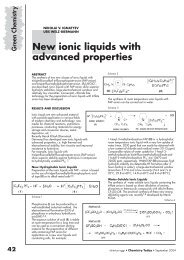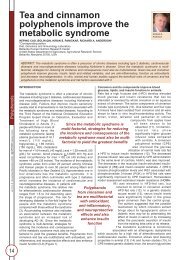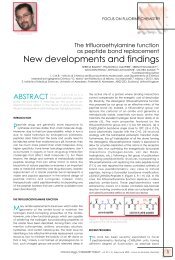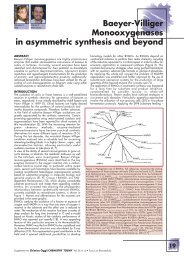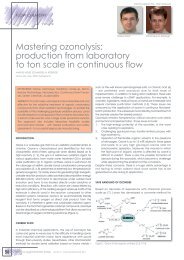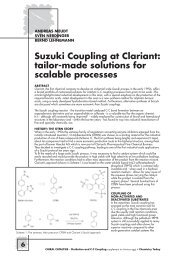Lake Como 2|4 October 2011 - CHIMICA Oggi/Chemistry Today
Lake Como 2|4 October 2011 - CHIMICA Oggi/Chemistry Today
Lake Como 2|4 October 2011 - CHIMICA Oggi/Chemistry Today
You also want an ePaper? Increase the reach of your titles
YUMPU automatically turns print PDFs into web optimized ePapers that Google loves.
SPEAKER SPEAKER SPEAKER SPEAKER SPEAKER SPEAKER SPEAKER SPEAKER SPEAKER SPEAKER SPEAKER SPEAKER SPEAKER SPEAKER SPEAKER SPEAKER SPEAKER SPEAKER SPEAKER SPEAKER SPEAKER SPEAKER SPEAKER SPEAKER SPEAKER SPEAKER SPEAKER SPEAKER SPEAKER SPEAKER SPEAKER SPEAKER SPEAKER SPEAKER SPEAKER SPEAKER SPEAKER SPEAKER SPEAKER SPEAKER SPEAKER SPEAKER SPEAKER SPEAKER SPEAKER SPEAKER SPEAKER SPEAKER SPEAKER SPEAKER SPEAKER SPEAKER SPEAKER SPEAKER<br />
ABSTRACT<br />
BIOGRAPHY<br />
How to develop continuous intensifi ed separations for fi ne-chemical industry?<br />
Mark Roelands, Ikenna Ngene<br />
TNO - The Netherlands<br />
Mark Roelands<br />
Mark Roelands works as Senior Research Scientist in the Process Intensifi cation team of TNO,<br />
the Dutch contract research organization, located at Delft in the Netherlands. His work<br />
focuses on Continuous Intensifi ed Separations for Flow <strong>Chemistry</strong>.<br />
Mark was educated as a Chemical Engineer at the Delft University of Technology and he<br />
holds a PhD from the same university, where he worked on continuous crystallization at the<br />
Laboratory for Process Equipment in the group of prof. Peter Jansens.<br />
For several years Mark worked in industry as a researcher at Akzo Nobel in a<br />
process technology support role with specialization on separations. In 2005<br />
he joined TNO’s separation technology department.<br />
In the Process Intensifi cation team Mark develops innovative<br />
equipment for (fi ne)chemical processes for the classical<br />
separations: evaporation, extraction and crystallization. Mark’s<br />
ambition is to bring the Volumetric Productivity of these separations<br />
to the same level as achieved in continuous reactors.<br />
The conventional way to carry out processes in fi ne-chemical industries is in batch operation in stirred tank reactors. These are<br />
not only used for chemical reactions but also for subsequent separations like evaporation, extraction, stripping and crystallization.<br />
However, stirred tank reactors are not effi cient for these tasks because of mass and heat transfer limitations.<br />
“Intensifi cation” of reactors and separations is an opportunity for fi ne-chemical industries to improve product quality, to lower<br />
processing cost and to achieve more sustainable processes. Over the last decade major steps forward were made in the<br />
development of continuous micro-structured reactors.<br />
The next step is the introduction of continuous micro-structured separation equipment that has a similar performance on<br />
separation effi ciency. For separation the major challenge is to scale down the volume of the equipment while maintaining<br />
productivity by controlling mass and heat transfer over interfaces (droplets, bubbles, particles and fi lms). It is not expected that<br />
existing large-scale separation equipment can be simply scaled down.<br />
The key performance indicator for intensifi ed processes is the Volumetric Productivity (VP) expressed as mass fl ow per unit volume<br />
of the equipment in [kg/m 3 /hr]. The volumetric productivity can be expressed as the product of the fl ux in the equipment and the<br />
specifi c surface area of the device: VP = J.e, with J = fl ux expressed in [kg/m 2 /hr] and e = specifi c surface area expressed in [m 2 /m 3 ].<br />
At TNO we developed two technologies for widely applied separations: extraction using intensifi ed contactor technology and fl ash<br />
distillation using micro-evaporator technology. We achieved proof-of-principles for:<br />
- solvent switch: transferring a compound from one solvent to another by evaporation;<br />
- aqueous work-up: removal of spent acid or base by extraction with water;<br />
- dehydration: extraction of reaction water.<br />
Our objective is to accelerate the development of these technologies by showing that the desired Volumetric Productivity is<br />
achievable for real industrial cases. Additional challenges to bring this promising technology into reality are: multi-purpose<br />
applicability, chemically resistant materials, modular construction for fl exible capacity and cost-effectiveness.<br />
20<br />
<strong>Lake</strong> <strong>Como</strong><br />
<strong>2|4</strong> <strong>October</strong> <strong>2011</strong>



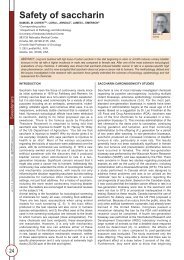
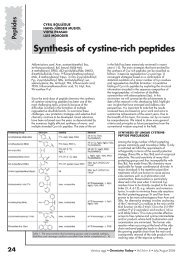
![Pietro Delogu [modalità compatibilità]](https://img.yumpu.com/12255149/1/190x135/pietro-delogu-modalita-compatibilita.jpg?quality=85)
